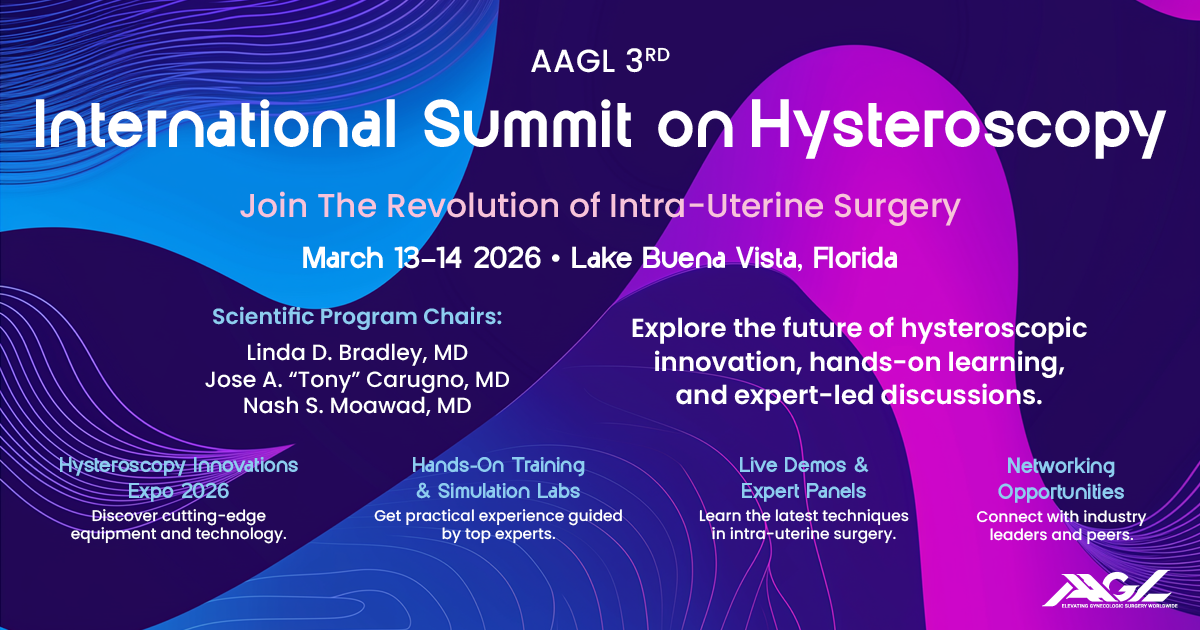Spotlight On: Urogynecology SIG

This month we are spotlighting articles and videos from the Urogynecology Special Interest Group led by Amy Park, MD, Chair and Soorena Fatehchehr, MD, Vice Chair.
SurgeryU features hundreds of high-definition surgical videos from surgeons from around the world. Access to SurgeryU is one of the many benefits included in your AAGL membership. If you would like access to these videos, CME programming, JMIG Journal, and member-only discounts on meetings, join AAGL today. These videos are being made available with public access for a limited time. Click here to join AAGL!
Videos
Article: Most Difficult Case Presentation: Abdominal Sacrocolpopexy Using a Combination of Autologous Fascia Lata Graft and Mesh for Post-cystectomy Pelvic Organ Prolapse by Sandip Vasavada, MD, Shannon Wallace, MD, and Jacqueline Zillioux, MD
Radical cystectomy in women traditionally involves removal of the bladder, urethra, uterus, ovaries, and anterior vagina. Following extirpation, the vagina is reconstructed, typically in a “clamshell” fashion wherein a posterior flap of vagina is developed and folded over to close the defect. Radical cystectomy thus disrupts multiple levels of vaginal support while the vaginal reconstruction invariably results in vaginal foreshortening with poor anterior tissue quality, placing patients at risk for post-operative pelvic organ prolapse (POP).
Though likely underreported, incidence estimates from limited literature on post-cystectomy POP range 4-23%.1,2 Furthermore, post-cystectomy POP is challenging to treat due to poor tissue quality, vaginal foreshortening, and an often-hostile abdomen. Pessaries are usually not viable options due to tissue quality, which anteriorly is often granulated peritoneum resulting from dehiscence of the vaginal reconstruction as opposed to normal vaginal tissue. Surgical management options include obliterative, vaginal native tissue or graft augmented repairs, and abdominal sacrocolpopexy. Robotic or laparoscopic techniques may be limited by ileal conduit and/or adhesions or radiation.
Case
We present a case of a 67-year-old woman who presented with bothersome vaginal bulge one year following robotic radical cystectomy with ileal conduit diversion for bladder cancer. On exam, she was found to have stage 2 anterior prolapse (“Ba”+1,“C”-2) with very thin tissue (Figure1). She desired to maintain sexual activity. After discussing management options, she elected to undergo abdominal sacrocolpopexy. We advised utilizing autologous fascia anteriorly and mesh posteriorly, as her posterior vaginal tissue was healthy and uninvolved in prior surgical dissections. Fascia lata was chosen for autologous graft.
She was positioned into low lithotomy with a short boot stirrup to allow access for fascia lata harvest. One team harvested a 4x8cm graft from the right fascia lata (Figure2), while another performed infraumbilical midline laparotomy to begin the sacrocolpopexy.
An EEA sizer was used to gently manipulate the vagina. Once the pelvis was accessed, it was apparent that the clamshell flap had dehisced along the left half of the reconstruction, with granulated peritoneum covering the defect. We re-approximated the dehisced edge using running 2-0 polyglactin suture (Figure3). The sacral promontory was identified, and we ensured that the conduit and left ureter were a safe distance superiorly before performing standard presacral dissection. The posterior vaginal plane was then developed. One strip of lightweight polypropylene mesh was secured posteriorly with interrupted delayed absorbable suture and 2-0 polypropylene at the apex. The fascia lata graft was secured anteriorly similarly. Interrupted 2-0 polypropylene sutures were used to affix the autologous graft to the mesh leaflet, and the proximal mesh arm was secured to the longitudinal sacral ligament with interrupted polypropylene sutures, resulting in excellent vaginal suspension (Figure4). There was inadequate peritoneum to completely retroperitonealize the mesh, so a sigmoid epiploic was secured to the left pelvic sidewall to prevent internal herniation.
References:
- Richter LA, Osazuwa-Peters OL, Routh JC et al. Vaginal complications after cystectomy: results from a Medicare Sample. J Urol 2022;207(4):789.
- Richter LA, Egan J, Alagha EC et al. Vaginal complications after radical cystectomy: a systematic review. Urology 2021;156:e20-29.
Authors: Professor Sandip Vasavada, MD Glickman Urological & Kidney Institute, Cleveland Clinic, Cleveland, OH; Shannon Wallace, MD, Center for Urogynecology and Reconstructive Pelvic Surgery, Women’s Health Institute, Cleveland Clinic, Cleveland, OH and Jacqueline Zillioux, MD Glickman Urological & Kidney Institute, Cleveland Clinic, Cleveland
Image 1

Image 2:

Image 3:

Image 4:

Article: Vaginal Natural Orifice Transluminal Endoscopic Surgery (vNOTES): the Latest Innovation in Gynecologic Surgery by Karl Jallad, MD, and Stephanie Farah, MD
There is a considerable interest in pushing the frontiers of minimally invasive surgery, which has led to the emergence of a new field in minimally invasive gynecologic surgery referred to as Natural Orifice Transluminal Endoscopic Surgery (NOTES). vNOTES represents one of the most significant innovations since the emergence of laparoscopic and then robotic surgery. Following its introduction in 2012, it has now gained worldwide attention. This technique has many advantages such as reduced intra-abdominal insufflation, faster surgical time, less trocar related adverse events, and better cosmetic results. It is also easier to adopt than single incision laparoscopic surgery given that the vagina allows for a larger access, thus less conflict between the instruments. Fortunately, there is now sufficient data confirming its feasibility and safety. Two randomized controlled trials were recently published by Baekelandt et al showing the emerging role of vNOTES in both hysterectomy and adnexectomy procedures. vNOTES was shown to be non-inferior to conventional laparoscopic approach. There was a shorter hospital stay following vNOTES hysterectomy. In addition, vNOTES adnexectomies allowed shorter operating times and less pain.
Interestingly, vNOTES can be a safe and successful technique for large and very large uterus and this might broaden the indications of vaginal hysterectomy. For Urogynecology, the technology is probably not needed for hysterectomy of small uterus at time of prolapse surgery but it’s a great tool for uterosacral suspension and data regarding the technique that is starting to emerge. There are some relative contraindications to vNOTES procedures including women who have had low colorectal surgeries, prior pelvic radiation, obliteration of the posterior cul-de-sac, and cervical myomas, especially when they constitute an anatomic barrier to the retractor. Additional contraindications include suspicion of malignant ovarian mass, severe endometriosis, pelvic adhesions, history of pelvic inflammatory disease, and presence of serious medical conditions preventing insufflation.
Adopting vNOTES requires decent laparoscopic skills and more importantly being comfortable performing a vaginal anterior and posterior colpotomy. Since vNOTES incorporates several different strategies to permit delicate access through the vagina, one should go through some form of training or proctoring prior to adopting this approach. Considerations of positioning, colpotomy and proper diagnosis of masses if present should always be made prior to vNOTES procedure to keep it as safe as possible. Clear cutoffs, guidelines and techniques are continuously being updated.
vNOTES is well proven to be a safe, feasible, and relatively cheap procedure. It is crucial to continue to develop novel instruments and techniques to further improve this approach. vNOTES will likely continue to gain momentum and perhaps be used for oncologic surgery and as a vaginal access for robotic surgeries.
Authors: Karl Jallad, MD, Acting Chair of Obstetrics, Gynecology and Surgery, Gilbert and Rose-Marie Chagoury School of Medicine, LAU Medical Center, Beirut, Lebanon; Stephanie Farah, MD, Post-Doctoral Research Fellow, LAU Medical Center, Beirut, Lebanon
References:
1.Jallad K, Walters MD. Natural Orifice Transluminal Surgery (NOTES) in Gynecology. Clin Obstet Gynecol. 2017 Jun;60(2):324-329.
2. Baeklandt J, Mulder P, Roy I, et al. Hysterectomy by transvaginal natural orifice transluminal endoscopic surgery versus laparoscopy as a day-care procedure: a randomized controlled trial. BJOG. 2019 Jan;126(1):105-113.








